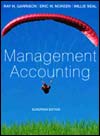 |
1 |  | 
Which of the following statements is untrue?
(Learning Objective 1 Ch 16) |
|  | A) | Product demand is elastic if a change in price has a big effect on the quantity of units sold |
|  | B) | Bargain basement products usually have inelastic demand |
|  | C) | The price elasticity of demand measures the degree to which unit sales are affected by a change in price |
|  | D) | Product demand is in-elastic if it has a small effect on the quantity of units sold |
 |
 |
2 |  | 
The formula for the price elasticity of demand can be said to be as follows:  <a onClick="window.open('/olcweb/cgi/pluginpop.cgi?it=gif::_::/sites/dl/free/0077098595/74294/16_02q.gif','popWin', 'width=NaN,height=NaN,resizable,scrollbars');" href="#"><img valign="absmiddle" height="16" width="16" border="0" src="/olcweb/styles/shared/linkicons/image.gif">_ (0.0K)</a>_ <a onClick="window.open('/olcweb/cgi/pluginpop.cgi?it=gif::_::/sites/dl/free/0077098595/74294/16_02q.gif','popWin', 'width=NaN,height=NaN,resizable,scrollbars');" href="#"><img valign="absmiddle" height="16" width="16" border="0" src="/olcweb/styles/shared/linkicons/image.gif">_ (0.0K)</a>_
If the price of a product “U” decreases by 20%, then the number of units sold will increase by 40%. The price elasticity of demand for U is therefore:
(Learning Objective 1 Ch 16) |
|  | A) | 1.51 |
|  | B) | 2.29 |
|  | C) | – 1.51 |
|  | D) | 12.29 |
 |
 |
3 |  | 
The profit maximising formula using variable cost and under certain conditions is:  <a onClick="window.open('/olcweb/cgi/pluginpop.cgi?it=gif::_::/sites/dl/free/0077098595/74294/16_03q.gif','popWin', 'width=NaN,height=NaN,resizable,scrollbars');" href="#"><img valign="absmiddle" height="16" width="16" border="0" src="/olcweb/styles/shared/linkicons/image.gif">_ (1.0K)</a>_ <a onClick="window.open('/olcweb/cgi/pluginpop.cgi?it=gif::_::/sites/dl/free/0077098595/74294/16_03q.gif','popWin', 'width=NaN,height=NaN,resizable,scrollbars');" href="#"><img valign="absmiddle" height="16" width="16" border="0" src="/olcweb/styles/shared/linkicons/image.gif">_ (1.0K)</a>_
The price elasticity of demand for product E is 1.2
The variable cost of making the product is £10
The profit maximising price would be:
(Learning Objective 1 Ch 16) |
|  | A) | 75% |
|  | B) | 133 1/3% |
|  | C) | 33 1/3% |
|  | D) | 25% |
 |
 |
4 |  | 
Product Q has the following details:
Materials £6 per unit
Labour £4 per unit
Overheads £10,000. These are absorbed on a units
Budgeted production 2,000 units
Markup Percentage 20%
Using the Absorption Costing approach, the price is:
(Learning Objective 2 Ch 16) |
|  | A) | £8 |
|  | B) | £18 |
|  | C) | £12 |
|  | D) | £2 |
 |
 |
5 |  | 
Product L has the following details:
Price £20. Absorption cost is £15. The markup percentage is:
(Learning Objective 3 Ch 16) |
|  | A) | 75% |
|  | B) | 133 1/3% |
|  | C) | 33 1/3% |
|  | D) | 25% |
 |
 |
6 |  | 
The Target Cost for a product is:
(Learning Objective 4 Ch 16) |
|  | A) | Variable Cost + Target Percentage |
|  | B) | Absorption Cost + Target Percentage |
|  | C) | Anticipated Cost + Target Percentage |
|  | D) | Anticipated Selling Price – desired profit |
 |
 |
7 |  | 
Q7 The following details relate to a proposed new product “V”
Price £30 (based on competitors prices)
Number to be sold at this price 100,000 units
Investment required £3,000,000
ROI required 20%
The target cost required for product “V” is:
(Learning Objective 4 Ch 16) |
|  | A) | £24 |
|  | B) | £20 |
|  | C) | £15 |
|  | D) | £30 |
 |
 |
8 |  | 
A company uses time and material pricing. One of the following is not an element of the time component rate of labour
(Learning Objective 5 Ch 16) |
|  | A) | National Insurance costs of an employee |
|  | B) | Costs of material used |
|  | C) | Profit allowance |
|  | D) | Allowance for time doing admin tasks |
 |
 |
9 |  | 
One of the following is not a true statement regarding Transfer Pricing
(Learning Objective 6 Ch 16) |
|  | A) | An Absorption Cost basis doesn’t provide an incentive to control costs |
|  | B) | A Variable Cost basis doesn’t take into account fixed costs |
|  | C) | Market pricing sometimes produces misleading ideas about the true cost of a product |
|  | D) | When a manager doesn’t have an alternative market for goods then a negotiated transfer price is best. |
 |




 2003 A McGraw-Hill Online Learning Centre
2003 A McGraw-Hill Online Learning Centre